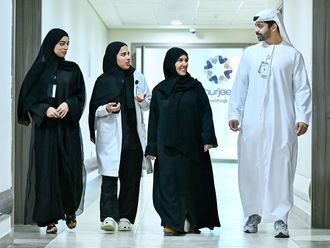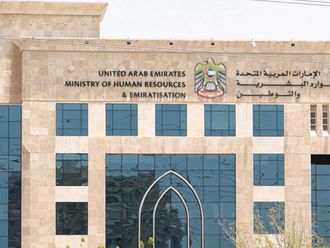
Dubai Health Authority (DHA) has developed a protocol using artificial intelligence (AI) to detect hospital-acquired infections and pre-empt sepsis early to prevent fatalities arising due to the condition. The protocol is the first of its kind in the Middle East and North Africa. Testing and training on the system began last week and it will go live mid November across all DHA hospitals.
The AI system is incorporated into DHA’s Electronic Medical Record, or Salama, to predict sepsis using modified early warning scores (Mews) and laboratory testing to save lives.
Sepsis is the body’s overwhelming response to infection, which can lead to tissue damage, organ failure and death. When a person gets sepsis, the body goes into septic shock. It can be treated and in many instances lives are saved by using existing and proven protocols.
Medical emergency
Worldwide, one-third of people who develop sepsis die. Many who do survive are left with life-changing effects such as post-traumatic stress disorder, chronic pain and fatigue and organ dysfunction. About 90 per cent of septic patients present to clinics and hospitals. Hospitals and clinics also have the potential to infect people, especially immunocompromised and geriatric patients.
Sepsis is a medical emergency that requires urgent attention and rapid treatment for survival. “Mortality from sepsis increases 8 per cent for every hour that treatment is delayed,”says the Sepsis Alliance report. “As many as 80 per cent of sepsis deaths could be prevented with rapid diagnosis and treatment.”
“Given the importance of early intervention in saving lives, we developed this system using international benchmarks to develop protocols in place that promote early intervention and management,” said Dr Younis Kazim CEO of Dubai Healthcare Corporation.
“The system uses AI technology that is linked to DHA’s Electronic Medical Record System. The AI algorithm reviews the progress of the patient and links variables together to identify patterns that indicate a patient maybe developing a severe infection. When the nursing staff enters vital signs (pulse, temperature, etc.) into the EMR, the system calculates a score. This scoring system is Mews.
“This is an international evidence-based tool that monitors the vital signs to flag changes if the patient is getting sicker. This score is then linked to recent laboratory results.
“If this score is 3 or above, an automatic warning comes to the nurse and the physician that this patient is at risk of sepsis.”
The Sepsis Management Workflow was developed by a team comprising both clinical and technical staff from all DHA hospitals. They worked together from January to identify the components of the system required and to build these actions within Salama.
How it works
Once the automatic warning is fired, the nurse contacts the physician urgently. Once the physician reviews the patient, they click on this warning and a set of orders is provided instantly to the physician. These orders include:
• Nursing instructions
• Laboratory tests
• Medications
• Intravenous fluids
This allows the first hour of treatment to start immediately. Dr Kazim said that DHA will continue to build its smart health capabilities with an aim to provide high-quality, patient-centric care. He said that smart technologies not only help improve patient care but also overall efficiencies and management systems of healthcare entities.
DHA is also working on the use of artificial intelligence-enabled workflows in radiology with Agfa HealthCare. The authority decided to use AI for X-ray imaging across medical fitness centres because of the scale of the service and the fact that it will greatly enhance work efficiencies and will lead to optimum utilisation of manpower.
Benefits of the system
• Early identification of patients at risk of sepsis as the EMR automatically identifies the patients becoming sicker and notifies both nursing and medical staff to take action
• Early start of sepsis management
• Improvement of sepsis outcome due to early identification and treatment
• Establishment of sepsis registry.
• Research shows mortality from sepsis increases 8 per cent for every hour that treatment is delayed. As many as 80 per cent of sepsis deaths could be prevented with rapid diagnosis and treatment, says a Sepsis Alliance report.












